How much is your collection of old postcards worth? Whether you are a seasoned collector or recently inherited the collection of a family member, the tips in this article will help you determine the value of your old postcards. If you are selling your collection, you certainly don’t want to price it too low – but also don’t want to price too high and scare away potential buyers.
Those new to the postcard world often feel overwhelmed when trying to value a collection of postcards. Some postcards sell for as little as a dollar or two, while others can sell for hundreds of dollars. The factors that make a postcard valuable often seem arbitrary. For example, the two postcards below may seem similar in value to the untrained eye.

Both are from smaller towns in New Jersey (South River has about 16,000 residents, while Bordentown has close to 4,000), both were published by The Eagle Post Card Company around the 1920s, and both are in very good condition for their age. They would be attractive cards for nearly any collector of the area, being in good condition without any postmarks or writing on the front.
How would you price these two cards? The one on the right is from a smaller town, so that may mean less cards were produced of that area – making it harder to find and more valuable. The card on the left has much better eye appeal: a street scene, old cars, drug store, other signage. Crazily enough, they have a significant difference in value. The card on the left sold at auction in June of 2022 for $177.50. The Bordentown card was listed in August of 2022 for $6.29 and is still available to purchase.
After reading this article, you will have a better understanding of why the South River card sold for so much – and how you can determine which of your postcards may be worth hundreds of dollars or may be worth a few dollars.
Factors that determine value
1. Scarcity
Scarcity and collectibility are the two biggest factors of determining the value of a postcard. Think of scarcity as supply and collectibility as demand. If a postcard is scarce but has no collectors, it doesn’t have much value. If a postcard has many collectors but also is very common, in relation to demand, it likewise will not be very valuable. Value exists in the world of postcards at the intersection of scarcity and collectibility: uncommon postcards in high demand command high prices.
Halloween postcards don’t command a high price solely because there are many collectors of Halloween postcards, they command a higher price because they are both highly collected and more difficult to find. Likewise, all of the topics below that are worth more, from certain holidays, subjects, real photos, artist-signed, coveted publishers, and more, are typically both highly collected and harder to find.
But my postcards are antiques, why aren’t they worth more?
A common misconception is that postcards have value solely because of their age. This may be true if postcards were produced in very limited quantities, but they were mass produced by the billions (about one billion per year were mailed in the United States between 1905 to 1915). This makes some antique postcards worth very little if they are common, but it is a blessing for collectors. Postcard collecting is special because of how accessible it is: anyone can own a piece of history for a few dollars.
Of the billions of postcards mailed during the Golden Age of Postcards, from 1907-1915, many are of popular tourist attractions. Think Niagara Falls, the Statue of Liberty, and skyscrapers in big cities. Harder to find postcards generally command a higher price. Postcards from smaller towns, states that didn’t have many postcards produced, and lesser-celebrated holidays (such as Halloween, Labor Day, and Groundhog Day) are all harder to find and therefore generally more expensive than easier to find subjects.
2. Subject Matter
The subject matter of a postcard affects the desirability to a collector and therefore affects the price.
Popular subjects include:
Busy street scenes
The more going on, the better. Pay attention to signs (drug stores, liquor stores, gas signs), trolleys, trains, early automobiles, and anything else going on.

Interior views
These are less common than views of the outside of a building and are often more interesting and desirable to collectors. I personally love looking at unique interior views of buildings from over 100 years ago. The outside of buildings may not change much over the years, but the inside will always look very different.
Night views
Night views are less common than daytime views and may command a higher price if they are less common. If you are selling a night view postcard, make sure to note that it is a night scene and whether or not the moon is visible.
Halloween
Halloween is one of the most collected holidays. Cards were only produced for the U.S. market, but are now collected worldwide, so they can be difficult to find. Nearly all Halloween postcards command a premium, with certain cards selling for hundreds of dollars.
Santa Claus
Who doesn’t love Santa Claus? Antique Christmas postcards featuring the jolly old man generally sell for more than Christmas postcards without Santa. Eye appeal is big here: the more colorful and “pretty” a Christmas postcard featuring Santa is, the higher the price, generally.
Pay attention to the color of Santa’s robe. Colors other than red normally go for more.

3. Eras and Types of Postcards
Before we get into different eras of postcards, a little background information is necessary. The eras below are considered the different eras of postcards in the United States. In other countries, timelines look a little different. There is also some overlap: dates are not strict bounds, but rather the years in which these postcards were most prominently produced.
Private Mailing Cards & Undivided Back (1907 and Earlier)
Early picture postcards were known as private mailing cards, produced from about 1898 to 1901. Most were souvenir or greeting cards, and town views were less common. The undivided back era began in late 1901 when the government permitted the words “post card” to be printed on the back of private mailing cards. Private mailing cards and undivided back cards both did not allow any writing except for the address on the back of the card. Views were often more primitive, especially earlier, and in black and white. The rise of full-color postcards coincides with the introduction of the divided back in 1907.

Divided Back (1907 – 1915)
Postcards from 1907-1915 were published during what is now known as the Golden Age of Postcards and are the most desirable to collectors. Postcards produced during this time period were mainly manufactured in Germany, and are of very high quality. They look and feel better than postcards from earlier and later eras. Colors are vibrant and cards from this era often feel glossy or smooth on the front. It’s important to remember that while this is called the divided back era, they were just the first postcards with a divided back, not the only. What makes divided back postcards unique is the high quality, full color, often glossy or smooth fronts.

White Border (1915 – 1930)
The German postcard publishing industry was never rebuilt after World War One, and postcard quality suffered as a result. The white border era, which began in about 1915, brought with it less attractive postcards with smaller pictures and white borders. While postcards with white borders had been produced sparsely for years, they become the most prominent type of postcard produced around 1915. The paper often has a rougher feel to it than cards from the divided back era. Still, postcards from this era can be highly desired by collectors. If someone has a choice between buying the same view printed on a divided back card or a white border card, expect them to choose the divided back card.

Linen (1930 – 1950)
The linen era began around 1930, named after the paper they were printed on, which gave these postcards a textured feel. Linen postcards have vibrant colors and certain subjects can be very collectible, such as those featuring motels, restaurants, neon signs, and old cars. In general, though, you can expect linen postcards to be worth less, on average, than undivided back and white border postcards. Linen cards began to die out in the 1940s and 1950s, but were still produced well into the chrome era (which you can read about below).

Chrome (1939 – Today)
Chrome postcards were first offered in the U.S. in 1939, but took some time to catch on. The 1940s and 1950s saw a great mix of both linen postcards and chrome postcards being produced. Chrome postcards offer sharper images than linen postcards and are still produced today, albeit typically at a larger size known as continental. Most chrome postcards produced are fairly easy to find today and are not worth more than a few dollars, but some less common scenes can have value. Especially popular are motels and hotels, restaurants, street scenes, and old cars. As always with postcards, the collectibility and scarcity of a card will be the ultimate factors that determine its value.

RPPCs (1900 – Today)
Real photo postcards (RPPCs), which started being produced around 1900, are highly collectible and can command higher prices than “regular” printed cards. Early on, negatives were the same size as the postcards themselves, so real photo postcards can have an amazing level of detail. RPPCs can typically be dated by the stamp box. Although much less popular today, real photo postcards have been produced from the very early 1900s to today. Earlier RPPCs are, on average, worth more than later cards, with certain subjects (such as busy street scenes, small town views, trains, old cars, and stores) commanding more.
If you aren’t sure whether your postcard is an RPPC, you can look at it under a magnifying glass. Printed postcard images will be made up of tiny dots or other printed patterns, whereas RPPCs, since they are developed and not printed, will have no such dots or printed patterns. Real photos also have a glossier feel than printed postcards and may have more of a “bend” to them from being developed. Some printed postcards, particularly collotypes, may look similar to RPPCs under magnification. Experience comes with time, and the more RPPCs you examine, the easier they will be to identify.

4. Artists
Postcard artists produced everything from colorful holiday scenes to anthropomorphic cats sending their kitten offspring to school. Some collect artist postcards they like or connect with, while others collect particular artists that produced many different postcards. Two of the most popular postcard artists are profiled below.
Ellen Clapsaddle
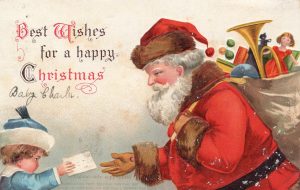
Ellen Clapsaddle, born at the tail end of the Civil War, was hired by the Wolf Publishing Company full-time around 1906 at the beginning of the Golden Age of Postcards. She previously freelanced for the International Art Publishing Company, the parent company of Wolf Publishing. Ellen devoted her life to postcards and was very successful in her role with Wolf Publishing, so successful that she moved to Germany to work directly with their engravers (Germany is widely considered to have made the best-quality postcards of the Golden Age, and many, if not most, postcards sold in the United States were imported from Germany).
The end of the Golden Age of Postcards coincides with the drop in German exports to the United States during World War One. In A Guide Book of Collectible Postcards, Ellen is said to have lost direction after the Golden Age came to a close and suffered a mental breakdown. Her work was no longer in high demand; while town and city views were widely produced after the Golden Age of Postcards came to a close, holiday postcards, which Ellen was known for, became less popular as printing quality declined.
One of the Wolf brothers came to Germany searching for Ellen around the start of the war, in 1914 or 1915. She was found walking the streets, alone and hungry, according to one source. Ellen came back to the states but was no longer working and mentally incapacitated. She was later admitted to the Peabody Home in New York City where she “had lost all mental reason and sat and played with toys until her death,” two years after admission in 1934 at the age of 68.
Ellen never married, had no siblings, and both of her parents were deceased decades before her own death. She died in poverty with “no record of her accomplishments.” But that’s not where Ellen’s story ends. Nearly 100 years after her death, she is one of the most collected postcard artists. Some of her postcards command hundreds of dollars. She was a trailblazer, one of the few female artists in the postcard world. She produced about 2,000 artist signed postcards, and many more unsigned postcards. Her work lives on today in the hands of thousands of collectors. The next time you see a postcard signed Ellen Clapsaddle, remember the woman who created it and devoted her life to the hobby we enjoy today.
John Winsch
John Winsch published mainly holiday-themed postcards at the height of the Golden Age of Postcards. He published the work of many different artists, and postcards are both signed and unsigned. Postcards with “Winsch backs,” featuring Winsch’s distinct imprint, can be highly sought after (Halloween postcards tend to be the most popular).
There were hundreds of postcard artists from 1907 to 1915, and many not listed here are also highly collectible. Some artists produced postcards that sell for thousands of dollars today. However, you can usually get postcards from even the most well-known artists for under $10.
5. Publishers
The Albertype Co.
The Albertype Company, named for the new albertype technology to reproduce photo images, was founded in Brooklyn in the late 1880s. They produced souvenir products other than postcards, but they are most known for the tens of thousands of postcards they published (meaning tens of thousands of different views). Unlike most other postcards of their day, Albertypes were American made.
Albertype postcards can normally be easily identified by the back (although some early posted cards only identified in the stamp box may not be easily identified). Earlier postcards are identified in the stamp box, with later cards identified in the divider.

Rotograph Co.
The Rotograph Company published around 60,000 different postcards from 1904 to 1911 (again, meaning 60,000 different views, with millions, if not over one billion, postcards printed). Rotograph cards can be easily identified by the style of writing on the front and by the Rotograph imprint on the back. Both Albertype Co. and Rotograph Co. postcards don’t necessarily command more than similar cards by different publishers, but they were two of the biggest producers of cards sold in the U.S. during the Golden Era.
Fred Harvey
Unlike the two publishers above, Fred Harvey postcards can command a higher price than similar cards by different publishers. The Fred Harvey Company owned and operated restaurants, hotels, and other businesses along railroads in the western part of the country. Many of their postcards were printed by the Detroit Photographic Company, later Detroit Publishing. The company had eight full-time photographers traveling around the United States taking pictures to turn into postcards. The company was known for its good food and first-class treatment of both customers and employees. It left a lasting legacy and their postcards are still highly collected today.
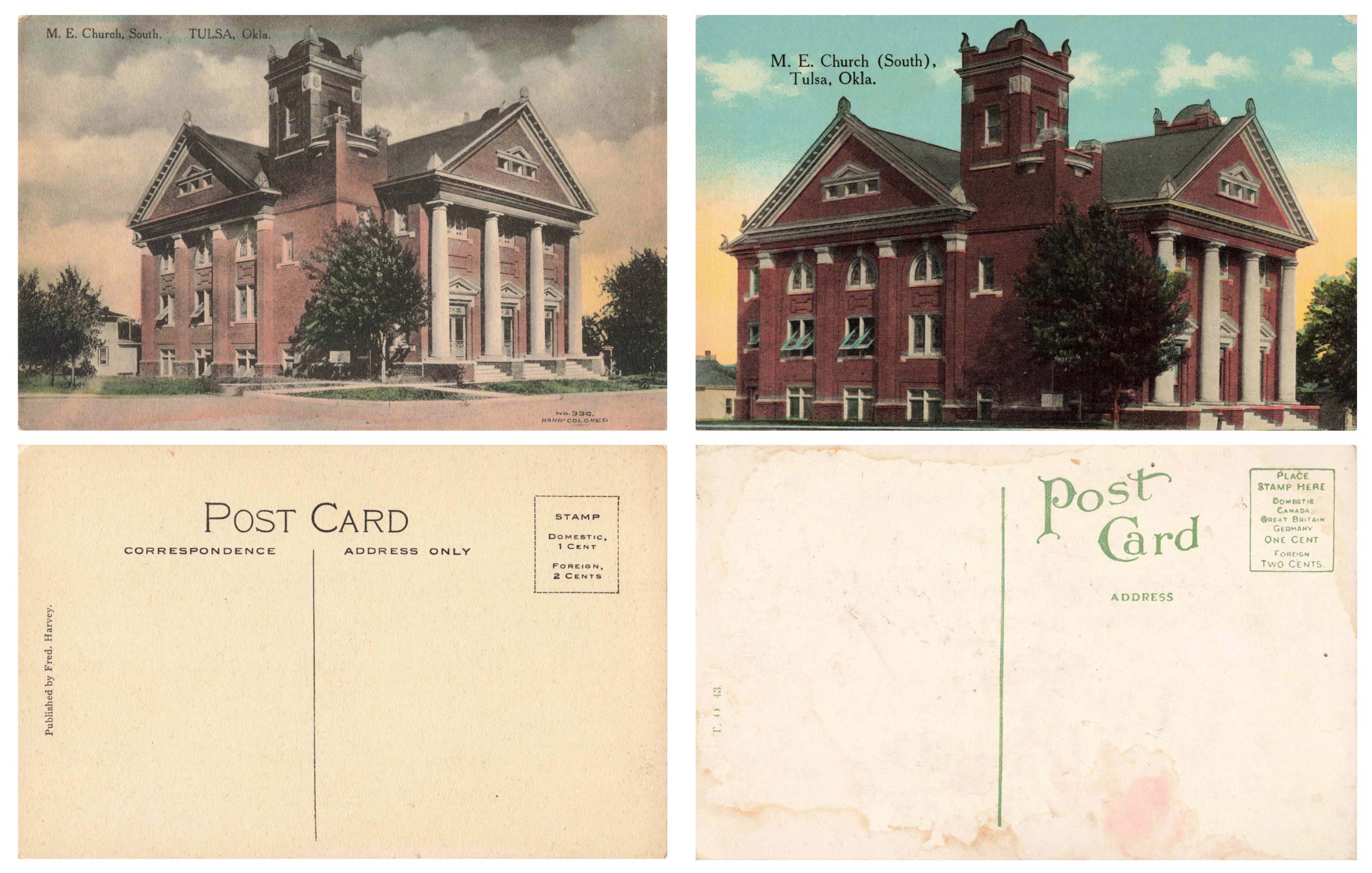
The Island Curio Co.
The Island Curio Company was created by a merger in 1912 and was a major producer of Hawaiian postcards. Pre-statehood postcards of Hawaii are very collectible in general, with the Island Curio Co. producing many of the most highly sought after cards.
Raphael Tuck & Sons
Raphael Tuck & Sons produced pictures and greeting cards in the mid-1800s, and later, postcards. They produced nearly everything, from holiday postcards, town and city views, of Europe, the U.S., and many other countries, historical figures, and artist postcards. The company headquarters was destroyed during World War Two and they unfortunately never recovered. TuckDB Postcards is a fantastic resource for researching the types and value of different Tuck postcards.
Wayne Paper Box and Printing Corporation
The Wayne Paper Box and Printing Corporation, which went by a few different variations of the same name, produced postcards from about 1933 to 1948. These postcards are often of historical importance as they produced postcards of small towns and in some cases are the only surviving image of certain buildings constructed during the depression. They can be easily identified by the silver border, on cards from about 1937 to 1943, or white border in earlier cards and white or gray border in later cards.
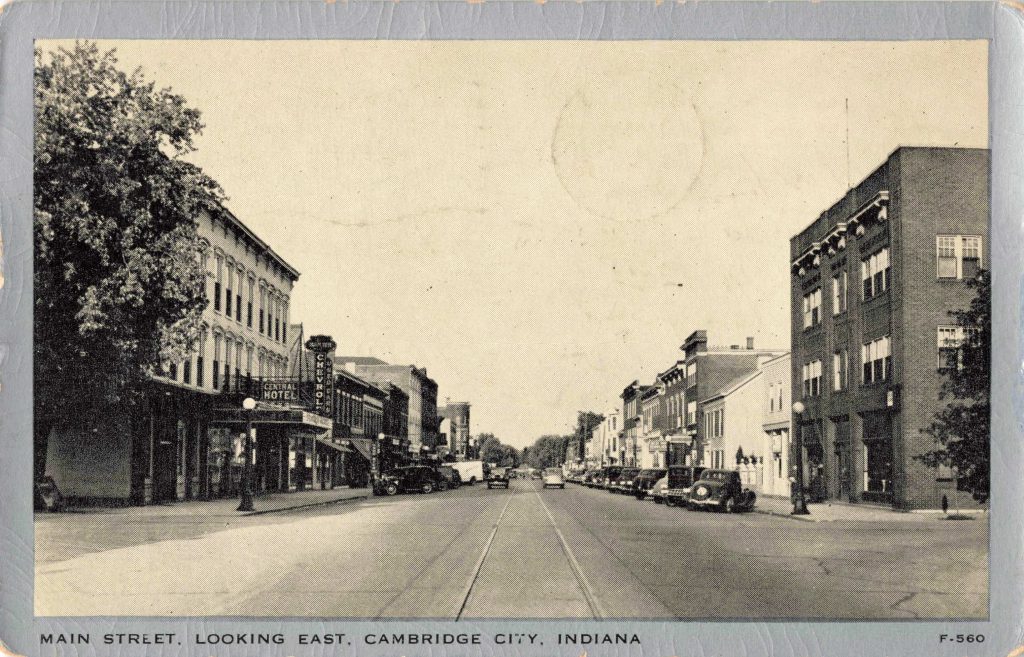
6. Postage Stamps and Postmarks
Another common misconception among those new to the postcard world is the value of the postage stamp. Nearly all postcards have extremely common stamps that don’t add or detract value from the postcard. Some collectors may prefer posted cards, while others prefer unused cards with no stamp or writing. If you ever see a unique or unfamiliar stamp, you can always look up the value online to see if it could be worth something. Postal cancels, or postmarks, are usually common and do not add value to the card, but can make a postcard worth significantly more. If you see a unique postmark on the back, it is definitely worth noting if you are selling (and another reason to always upload images of the back of postcards).
7. Writing on the Back
Some sellers on eBay will put the sender or recipient of a postcard in the title or description of a listing. While this is a nice thought, the vast majority of collectors are more interested in the front than the back. However, this does not mean that the back can not be of value. Many relatives or descendants would love to find a postcard written to or from someone from a previous generation. I don’t own any ephemera sent to or from previous generations in my family, but I would be ecstatic if I ever found any. That’s one of the reasons why I contribute digital copies of postcards to EphemeraSearch, a website dedicated to connecting people to postcards their ancestors sent or received. If you’ve never visited the site, I highly suggest searching for your surname and seeing what you find.
Writing on the back is not only valued for genealogical reasons. Notable and famous people sent postcards, too. I personally own postcards sent from Laura Corrigan, a wealthy American socialite and philanthropist, and Mary Creswell, the first woman to receive an undergraduate degree from my alma mater, the University of Georgia.

Resources to use to value your postcards
Knowing what is collectible and scarce will give you a good idea of how much a postcard may be worth, but don’t go off instinct alone. Back to the example at the beginning of the article: two similar small-town New Jersey postcards from the same time period and the same publisher in great condition have drastically different values. I primarily use two tools to value individual postcards, eBay and WorthPoint. On eBay, you can look at what is currently for sale and what has sold in the last 90 days (or one year, if you have an eBay store subscription with access to Terapeak). Knowing what a card is currently listed for and what it has previously sold for enables you to more accurately price it. Sometimes, though, a card won’t be listed for sale and you will not be able to find any copies that have sold recently. For these cases, I use WorthPoint. Data goes back over 15 years so you can see price history for extremely uncommon cards that may only come up for sale once a decade. Just because a card is not on eBay does not mean it is valuable or rare; WorthPoint can help you determine if it is an uncommon card worth a lot or an uncommon card worth a little.
In rarer cases, you may not find an example of a postcard ever selling before. For example, let’s say you are researching the price of a postcard of a Catholic church in a small town. If you can’t find any example of a postcard of this particular church, you may try searching for any churches in this particular town that sold. If that doesn’t work, try searching for all postcards from that small town that have sold. I have never yet come across a case where I could not find the price history of at least one postcard from a particular small town.
The bottom line about a postcard’s value: it is worth what someone will pay, no more and no less. Sometimes an extremely uncommon card might only sell for a few dollars if there is only one buyer and they are not willing to pay more than a few dollars.
What is my collection worth?
There are a few general rules of thumb if you are trying to value an entire collection rather than a single postcard. At listed, retail value, unpicked collections of highly collectible postcards tend to sell for around $10 per individual card (not in bulk; this is only for cards listed individually). Some may average more, if there are a greater number of uncommon cards or RPPCs, and some may go for less if there are a greater number of more common postcards. So far this year on eBay, as of August 21, 2022, I have sold over 3,500 cards with an average selling price of $10.81, before accounting for taxes, fees, and selling costs.
If you are selling your collection in bulk, it is unreasonable to expect anywhere near $10 per card unless you have a very, very special collection (like if your great-grandfather was a passenger on the Titanic and sent postcards of the ship before it sunk). When buying collections, I try to pay no more than $1 per card, and often $0.50 per card or less. Keep in mind I look for collections with higher dollar cards that will move quickly – if you sell more common postcards, your cost per card should be around $0.05 to $0.10 per card. As a reseller who buys collections, I do my best to offer a fair price for collections, after accounting for my time to list, sell, and ship postcards and all fees and taxes associated with doing so.
If you have a collection you want to estimate the value of, you first need to determine what types of postcards you have. Are they real photos? Small town views? Other highly collectible subjects? If so, you may use a multiplier of $0.50 x the number of cards in the collection for a very rough estimate of value if sold in bulk to a dealer. If you have more common cards, the multiplier will likely be less. I am always more than happy to take a look at your collection for free (no strings attached) and give my opinion. If you’d like me to take a look at your collection, you can email me directly.


